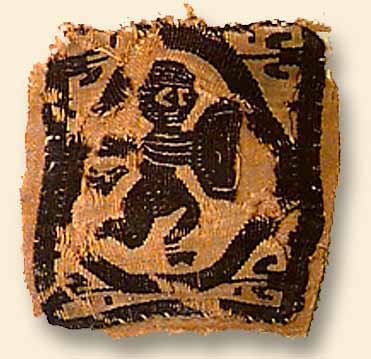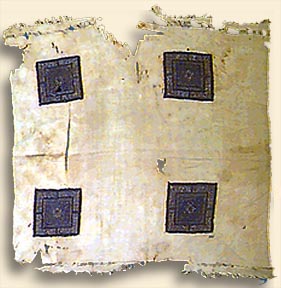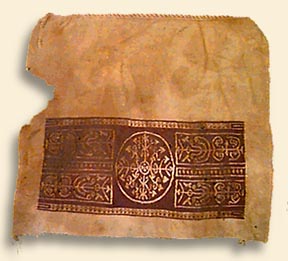

The Rietz Coptic Textile Collection
Square
Tunic Ornament
CAS 0389-2430

More than 75 textile fragments make up Rietz Coptic Textile collection in the Department of Anthropology at the California Academy of Sciences. All of the Coptic textiles in the Rietz collection are combinations of linen and wool or are only wool, except one textile made of silk. There is a group of nine textiles reputed to be from the ancient city Antinoopolis, (Shaikh Abada or El Sheik Abara), which had been a significant weaving center in the Coptic period. Because the accurate dating of Coptic textiles is very difficult, the dates given for the textiles should be considered estimates. Sixteen of the textiles in the Rietz collection are attributed to the early Coptic period of Roman domination. Twenty-two textiles are from the middle period of Byzantine rule, from the fifth to mid-seventh century. Thirty-one textiles are from the period of the Arab conquest onward to the eleventh or twelfth century.
Description: This monochromatic textile is reddish brown on a tan ground. The design features a wide-eyed running warrior in a circle within a square, with the corners of the square containing plant motifs. Materials/Construction: The textile has a linen tabby foundation, with the decoration being wool and linen tapestry on grouped linen warps. Measurement: 9 x 9 cm. Date: Sixth century. Accession number: CAS 0389-2430.
Coptic textiles are very difficult to date because the vast majority of them were acquired by looters or amateur archaeologists. At the time when most of the textiles were collected, the archaeological methods of survey had not been developed, and so records are often incomplete. The looters often destroyed the archaeological contexts completely. The lack of an archaeological context makes it very difficult to ascertain scientific dates for the textiles.
Most of the dating of the Coptic textiles is done by stylistic comparisons and comparisons to other arts. One difficulty in this method is that while the stylistic differences are likely to be temporal differences, there is the possibility that the differences could be between metropolitan and provincial styles, or that certain textiles were of foreign manufacture.

The early collectors further damaged the contexts of the textiles because they often cut the textiles into pieces, keeping only the colorful, decorative pieces. Therefore, most of the surviving textiles are just ornaments or fragments, making it difficult to determine the original form and function of the textile.
Description: This squarish piece of plain, light tan ground fringed cloth is decorated by four dark purple square ornaments. The square ornaments feature geometric designs worked in tan. Materials/Construction: The ground is line rep, the tapestry squares are wool on line warp. The weft-float patterning of the surface was worked in two gauges of linen yarn. The ground has decorative ridges mad from groups of bundled weft yarns placed at intervals. Measurement: 73 x 69 cm. Date: Late fourth or early fifth century. Accession number: CAS 0389-2375.
(Click
on image to see detail.)
There are not many Coptic textiles with distinct Christian themes or symbols. The few textiles with narrative scenes that exist usually depict Old Testament stories, like the Genesis story of Joseph, the Hebrew vizier of Egypt. Although the Christian Egyptians were a minority and were persecuted in the third and fourth centuries, religious persecution is not a complete explanation, since most of the extant textiles date from after that period.
One explanation may be that the textiles were not produced solely for the Christians in Egypt, but also for the Greeks, Jews, and Arabs, as well as for trade throughout the Mediterranean. The Romans in particular requested Classical imagery on their textiles. Also, not all Coptic textiles were made by the Christian Egyptians, but by other, non-Christian Egyptian weavers of the time.

Another explanation may be that there are numerous paintings, especially in Coptic churches, of Christian Egyptian saints, martyrs, and other heroes. Perhaps the Copts preferred their religious imagery in sacred buildings and did not have a strong need for Christian motifs on their clothing. Finally, although the Arabs did allow the Copts artistic freedom at first, the Islamic mandate against depicting figurative images heavily altered the textiles. The textiles became a lot more abstract after the Arab conquest.
Description: The sleeve
features a red-purple insert on beige ground. The equal-armed cross in the center
is disguised and highly decorated with stylized vines, leaves, and grapes. The
side panels have motifs that suggest crosses and anchors. The abstraction and
stylization of the design may be because the wearers wanted to make the required
Christian indicators of their clothing as inconspicuous as possible. Materials/Construction:
This textile is made of wool, in a tapestry weave with different thread counts
in the ground and ornament. There are a few embroidered details. Three selvages
are preserved. Measurement: 24.7 x 28.4 cm. Date: Eleventh century. Accession
number: CAS 0389-2401.
| Coptic Textiles Home | History of the Copts | Coptic Stylistic Groups | Coptic Weaving Technology |
| Coptic Textiles Collection | Resources | Online Exhibits Home | Anthropology Home |